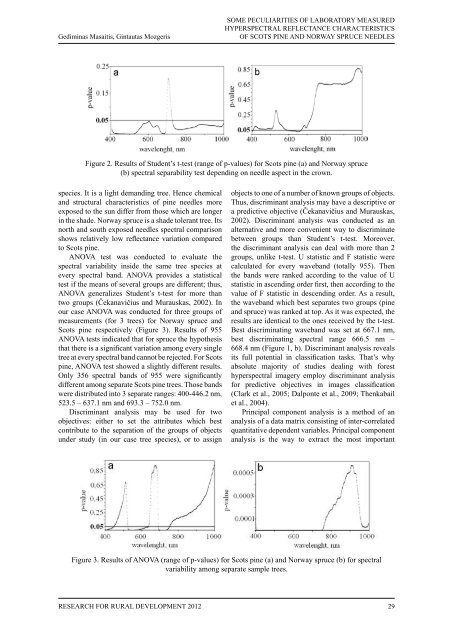RESEARCH FOR
RESEARCH FOR
RESEARCH FOR
You also want an ePaper? Increase the reach of your titles
YUMPU automatically turns print PDFs into web optimized ePapers that Google loves.
Gediminas Masaitis, Gintautas Mozgeris<br />
species. It is a light demanding tree. Hence chemical<br />
and structural characteristics of pine needles more<br />
exposed to the sun differ from those which are longer<br />
in the shade. Norway spruce is a shade tolerant tree. Its<br />
north and south exposed needles spectral comparison<br />
shows relatively low reflectance variation compared<br />
to Scots pine.<br />
ANOVA test was conducted to evaluate the<br />
spectral variability inside the same tree species at<br />
every spectral band. ANOVA provides a statistical<br />
test if the means of several groups are different; thus,<br />
ANOVA generalizes Student’s t-test for more than<br />
two groups (Čekanavičius and Murauskas, 2002). In<br />
our case ANOVA was conducted for three groups of<br />
measurements (for 3 trees) for Norway spruce and<br />
Scots pine respectively (Figure 3). Results of 955<br />
ANOVA tests indicated that for spruce the hypothesis<br />
that there is a significant variation among every single<br />
tree at every spectral band cannot be rejected. For Scots<br />
pine, ANOVA test showed a slightly different results.<br />
Only 356 spectral bands of 955 were significantly<br />
different among separate Scots pine trees. Those bands<br />
were distributed into 3 separate ranges: 400-446.2 nm,<br />
523.5 – 637.1 nm and 693.3 – 752.0 nm.<br />
Discriminant analysis may be used for two<br />
objectives: either to set the attributes which best<br />
contribute to the separation of the groups of objects<br />
under study (in our case tree species), or to assign<br />
ReseaRch foR RuRal Development 2012<br />
SOME PECULIARITIES OF LABORATORY MEASURED<br />
HYPERSPECTRAL REFLECTANCE CHARACTERISTICS<br />
OF SCOTS PINE AND NORWAY SPRUCE NEEDLES<br />
Figure 2. Results of Student’s t-test (range of p-values) for Scots pine (a) and Norway spruce<br />
(b) spectral separability test depending on needle aspect in the crown.<br />
objects to one of a number of known groups of objects.<br />
Thus, discriminant analysis may have a descriptive or<br />
a predictive objective (Čekanavičius and Murauskas,<br />
2002). Discriminant analysis was conducted as an<br />
alternative and more convenient way to discriminate<br />
between groups than Student’s t-test. Moreover,<br />
the discriminant analysis can deal with more than 2<br />
groups, unlike t-test. U statistic and F statistic were<br />
calculated for every waveband (totally 955). Then<br />
the bands were ranked according to the value of U<br />
statistic in ascending order first, then according to the<br />
value of F statistic in descending order. As a result,<br />
the waveband which best separates two groups (pine<br />
and spruce) was ranked at top. As it was expected, the<br />
results are identical to the ones received by the t-test.<br />
Best discriminating waveband was set at 667.1 nm,<br />
best discriminating spectral range 666.5 nm –<br />
668.4 nm (Figure 1, b). Discriminant analysis reveals<br />
its full potential in classification tasks. That’s why<br />
absolute majority of studies dealing with forest<br />
hyperspectral imagery employ discriminant analysis<br />
for predictive objectives in images classification<br />
(Clark et al., 2005; Dalponte et al., 2009; Thenkabail<br />
et al., 2004).<br />
Principal component analysis is a method of an<br />
analysis of a data matrix consisting of inter-correlated<br />
quantitative dependent variables. Principal component<br />
analysis is the way to extract the most important<br />
Figure 3. Results of ANOVA (range of p-values) for Scots pine (a) and Norway spruce (b) for spectral<br />
variability among separate sample trees.<br />
29


